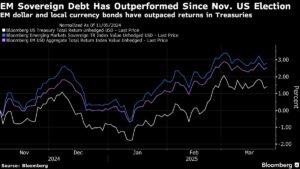Emerging Markets: The Next Big Opportunity?
As the financial landscape shifts under the influence of economic anxieties regarding the U.S., investors are increasingly turning their attention to emerging markets (EM) as a promising alternative. The underlying psychology here is simple: if the U.S. is likely to face economic headwinds due to tariff policies, then diversification into EM can serve as a smart hedge.
Current Trends in Emerging Markets
Recent trends show a compelling rise in EM equities, set to experience their best first quarter since 2019. The weaker U.S. dollar has bolstered the performance of developing currencies, lifting them by nearly 2% this year, while local bonds have also shown resilience. Portfolio managers are engaging with a variety of assets, from Latin American currencies to Eastern European bonds, suggesting a newfound optimism surrounding this often-overlooked asset class.
Bob Michele, global head of fixed income at JPMorgan Asset Management, notes that after years of focus on U.S. assets, emerging markets are finally starting to look undervalued. This shift is particularly striking when we consider that many emerging market stocks are at their lowest relative valuations compared to the S&P 500 since the late 1980s.
The Broader Context
Investors are faced with a dichotomous scenario. On one hand, emerging markets have historically been characterized by false dawns, suffering as surging U.S. stocks often eclipsed their returns. However, many now see this as an inflection point. The potential cooling of the U.S. economy—exasperated by tariffs—might ultimately lower Treasury yields and diminish the strength of the dollar.
This is a delicate balance. A mild slowdown could create the favorable conditions needed for EM growth. Investors are banking on increased government spending in Europe and stimulus efforts in China to bolster economic activity and absorb the shock from any U.S. deceleration.
Valuations and Trends in Emerging Markets
The urgency for a portfolio reallocation into emerging markets stems from the undeniable fact that they have been underrepresented in many global portfolios. The sheer potential for growth is immense. If capital flows back into EM—especially as U.S. assets lose their shine—it could offer fertile ground for rising asset prices. This is not just speculation; analysts from the Ashmore Group have suggested that the shift away from U.S.-centric investments may be a decade-long trend, making emerging market exposure not just a tactical move, but a strategic necessity.
Identifying Opportunities
Edwin Gutierrez from Aberdeen Asset Management points to the unique challenge posed by the current economic climate, which could uniquely benefit emerging markets. He notes that while many have been cautious, he’s now increasing allocations to emerging European bonds after years of underrepresentation.
Analysts from BlackRock highlight Latin America as a particularly ripe area for investment, recommending local EM bonds as an attractive buy amid any temporary weaknesses attributed to trade uncertainties. Funds like TCW Group and T. Rowe Price are already capitalizing on this opportunity, increasing their positions in Colombian and South African bonds, which promise high liquidity and market access.
Navigating Risks and Rewards
Of course, every investment strategy comes with risks. A resilient U.S. economy could dampen these bullish sentiments. Investors who are cautious are still holding positions in emerging market bonds while elevating their cash reserves—an exercise in prudent risk management.
For those prepared to embrace the potential of emerging markets, the current environment offers a unique chance to diversify and capitalize on mispriced assets. Given the macroeconomic shifts and the potential undervaluation of EM assets, a calculated approach to emerging markets could be exactly what your portfolio needs.
In summary, while the U.S. may still be the land of opportunity, emerging markets are ready to shine for those willing to take the plunge. The combination of solid fundamentals and external pressures could make this the perfect time to look beyond the familiar and explore what emerging markets have to offer.

